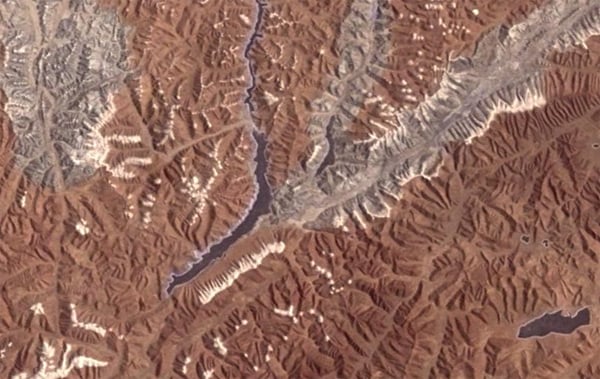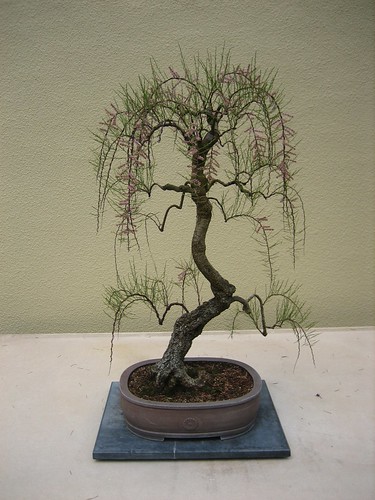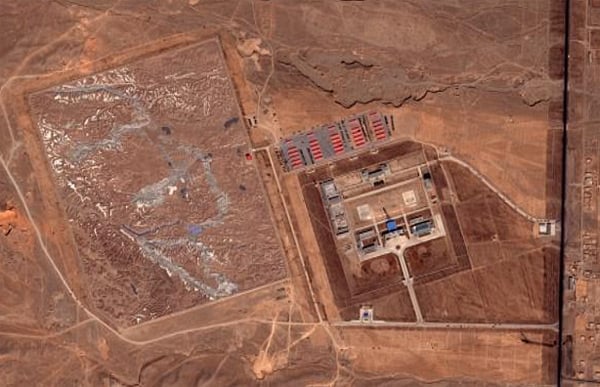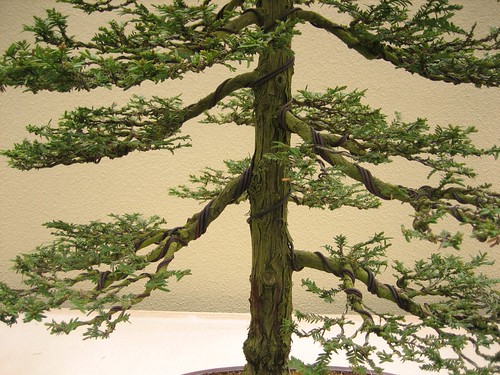Garden :: Bonsai China

Much as I love a bandwagon, I can’t resist taking the wheels off this one. You will have noticed that the blogsphere has been agog with the discovery of a scale-model landscape adjacent to a remote Chinese ‘military facility’. Someone with far more time and geographical obsession than me (or any nominally sane person), contends that it is a scale model of an obscure section of mountain with the sole distinction of being a bit of disputed border between China and India. Suggestions have been floated that it is a training landscape for helicopter pilots or troops.
!!!
Do they think that the Chinese would shrink their pilots down to match the scale? Surely a squad of pre-adolescent BMF-bandits would be more likely? (Although I have to admit that I'm rather taken with some of Pruned's hypotheses...topography trophies mmmmm)*.
I can’t let this pointless controversy go on. Obviously I am going to have to ‘fess up…
Please, forget the border connection; China is not gearing-up to invade India with a crack team of dwarf pilots and/or infantry squads of little people. This is a perfectly innocent research facility. Currently it is fully occupied assisting with my explorations into extreme gardening. That is not a scale model as has been proposed but an actual re-creation of MoD’s front yard. This allows us to trial various experimental landscaping concepts and design options.
As regular visitors will have realised, landscaping is not something to be undertaken lightly. Or by the un-prepared. I have personally been researching various materials, textures and finishes. I have shared several sample of that research with you, here in the Museum of Dust. But sometimes samples are not enough. You have to actually try one thing with another to see if they work together. For instance, I was planning a tasteful combination of clay-slurry, salt pans and booming sands. I had drawn up plans and sourced suppliers when test-results came back from Huangyangtan. The combination just wasn’t going to fly. The slurry made the sand dunes too soggy to sing and eroded the subtle fractal crackling pattern of the saltpan. So it’s been back to the drawing-board, but at least I have saved a fortune and an infinity of time and heartache.
And there’s no point of continuing to make sarcastic remarks about the probability that this remote station could possibly be anything other than a covert military facility. Perhaps it is because you believe that if the US tell us it is, it must be? But China is a new country and business is encouraged. Not least by the spectacularly low wages and lack of protection for workers’ oh&s… or rights. I can achieve my own research outcomes at a fraction of the cost of undertaking it in Europe… or even New Zealand. Skilled motivated workers and land are cheap in Huangyangtan.
But, and this is really what bends my fender, it just goes to show the level of general ignorance about Chinese culture.
Any fool knows that China has been at the leading-edge exploration of miniature and highly managed landscapes foe millenia. This, of course, is what makes China uniquely suitable for my purposes. Its tradition. No one has a longer history. The art of bonsai, for example, finds its genesis the whim of a Han Dynasty Emperor.
“255-206 B.C.E: Emperor Q'in Shih Huang Ti, the emperor who started history by burning all the books that had preceded his reign, sent men of the arts, sciences, horticulture, and floriculture to all his provinces with instruction to recreate representative replicas of each canton's landscape in miniature, and bring them back to the palace. He instructed them to portray each canton, complete with people, animals and all architectural features, in such a way that seasonal changes would also be an integral part of the landscapes. He wanted to see the rivers and streams, lakes and ponds, and mountains and valleys, he wanted to know the infinite variety of his possessions in all their aspects and manifestations. He knew it would be years before the penjings would be delivered to the Forbidden City, and while he waited he had a map of China carved into the marble surface of his personal courtyard, and had pedestals placed in the centre of each canton for each miniature landscape to rest upon.” From Manual: A User’s Baedeker (catalogue essay for Martine Corompt’s exhibition ‘Dodg’em’).To honour this proud history, I am almost certain that I’ll devote at least a section of the Terra Incognita lanscape to bonsai. Maybe a forest on the west side of the Museum…? What is certain, if I do, I’ll be choosing my specimens from the nadjs’s exceptional collection.
the nadj's photostream >>
Pacific Rim Bonsai Collection set >>
* "In actuality, it's the modern equivalent of spoils-taking. Forget about the gold, the obelisks, giant menorahs, virginal (or otherwise) women or chunks of churches, mosques and palaces. The victors will slice off entire topographies and then truck it all back to the homeland: Israel transplanting a mountain or two from the Anti-Lebanon to the Negev Desert once the current incursion ends; or after another Turkish-Greek incident has concluded, a Greek island placed atop a pedestal in front of Atatürk's mausoleum; or a segment of the Tigris and the Euphrates shipped off to Nebraska on a C-130. And with landscape architects channeling Albert Speer and Leni Riefenstahl, there will be parades and mass celebrations as lavish as any organized by Kim Jong-il." Pruned



5 Comments:
Hey! Don't forget about the mini-collection of mini-bonsai at your own (once proudly independent) Zymoglyphic mini-Museum!
Once I have 3 of anything I call it a collection!
Thank you for bringing it to my attention, Mr S. I knew that there was a reason we allowed you to stay on. And to think Inky and Admin tried to tell me I was just being sentimental... this'll show them. I didn't notice any of them reminding me of the bonsai collection in the Zymoglyphic Museum...
Of course, now it raises the issue of creating some kind of special enclosure within our planned bonsai forest to protect and adequately exhibit the bonsai bonsais...
Cog, sorry to be the pedant, but I thought I should point out (for the benefit of readers) that the Emperor Qin Shihuangdi (or Ch'in Shih-Huang-Ti)was not an emperor of the Han Dynasty (206 BC - 220 AD). He was, in fact, an emperor of his very own Qin (Ch'in) Dynasty (221-206 BC).
I bother to mention this because the Han Dynasty took as its state ideology the teachings of Confucianism, as found in the very books which Qin wanted to burn. So although Qin began the imperial dynastic system which continued down to the early 20th century, he was never considered by subsequent dynasties (eg. the Han) to have 'started history'. If this had been the case, we would know nothing of Confucius, or Taoism, or other basic elements of Chinese classical culture which Qin tried to stamp out. I just can't let anyone slander the Han dynasty in this way!
I'm not sure what the implications of this are for the history of bonsai. Obviously it can't be both a Qin era and a Han era invention. . . certainly Qin was known to have spared the horticulturalists from his bloody purges. And to have done extreme things worthy of the story you give. But as far as I know, historians can't establish that bonsai really existed before the Tang dynasty (618-907 AD), around the same time that it was introduced in Japan.
Kind regards,
Danxia, Minister for Semi-Natural Structures, Republic of Tinselman
How clever are you? You have create an interesting and informative site. This site is basis on bonsai tree. A bonsai is not a genetically dwarfed plant. It is kept small by shaping and root pruning. There is a beautiful bonsai garden in china. I wants to visit this wonderful place.
Nicce blog post
Post a Comment
<< Home